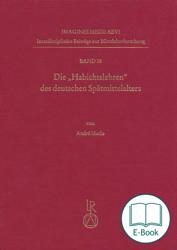Not before their successor, the “Beizbüchlein”, was published as the very first printed book on hunting in Europe, the so-called “Habichtslehren” (“goshawk-lore”) got to some publicity and made quite remarkable impact on the development of a widespread and highly relevant cultural technique of medieval society. The work at hand closes many gapes in research by editing the three known German manuscripts newly resp. for the first time, but also translating and extensively annotation them. Moreover the question asked since the 1960s on the origin of these texts in the German dialect´s landscape can be answered coherently. A comprehensive description of the guild-bound “falconer’s language” forms the third part of this volume.
This volume closes many gapes in research regarding the “Habichtslehren” – the over many centuries virtually unnoticed first original treatises on falconry in German language. First, as not only the two manuscripts published by Kurt Lindner are revised and newly edited, but especially because of the first edition and extensive annotation of the “Jüngere Habichtslehre”, an interstage not yet known in the 1960s, but crucial for understanding the genesis of these writings. From the very beginning a work was intended, that would not only develop some relevance for indo-european, medieval or codicological studies, but also be of fruitful use for contemporary falconers, enthusiasts for hawking itself or historically working ornithologists. Thus all three German manuscripts we know of, including the discussion of the Latin manuscript L, are available in one volume concluding the latest state of knowledge. Here already a great progress in editing the primary sources of that time stands out.
In the second part for the first time the question asked since the 1960s on the origin of these texts in the German dialect´s landscape can be answered coherently. Alongside a complex and meticulous analysis of the manuscripts explaining their geographical provenience by examinating their linguistic characteristics non-linguistic facts are also considered as an argument, in particular the ancient distribution of the mentioned game species. In this way a second, completely independent chain of evidence can be established, which’s combination with philological methods allows only one conclusion.
The very fruitful cultural connections so typical for falconry itself express themselves in particular in the vitality of the “falconer’s language”, an early guild idiom, that has included many stimuli and influences from a variety of languages and cultures. To fathom these relations is the pretension of the third chapter. Every technical expression encountered in the “Habichtslehren” undergoes an elaborate examination in terms of his first appearance in German, his contemporary use, meaning and etymology. In the course of this not only know interpretations were reported, but many new suggestions put forth. In this part also there was no exclusive focus on linguistic methods but on a synthesis with the documented facts of biology and ornithology. Without that many coexistent opportunities causing problems of interpretation would have to be left undecided resp. unsolved.
„Die Arbeit stellt sich der dringend notwendigen Neubearbeitung und vereint überlieferungskritische, editorische, sprachhistorische und kultur- bzw. jagdhistorische Aspekte. Neben der Älteren Habichtslehre wird die Jüngere Habichtslehre erstmals als eigenständige Fassung behandelt und ediert. Der erfreulich quellennahe Textabdruck bietet auch sprachhistorischen Fragestellungen eine sehr gute Ausgangsbasis, den Mehrwert der Edition machen die fachlich fundierten Uebersetzungen und die kenntnisreiche Kommentierung aus. (...) Von außerordentlichem Wert nicht nur für die Fachsprachenfoschung ist die Sammlung fachsprachlicher Lexeme und deren etymologische Untersuchung inkl. der Nachzeichnung der semantischen Entwicklungslinien.“
Von: Simone Schultz-Balluff
In: Germanistik, 2017, bd. 58, Heft 3-4, S. 809-810
-----------------------------------------------------------------------------------------------------------------------------------
„Ein besonderer Mehrwert liegt in der Skizzierung der fachsprachlichen Entwicklungslinien bis heute. Auch hier besticht der außerordentliche Kenntnisreichtum der sachlichen Anmerkungen. Die sorgfältige und akribische Aufbereitung bringt einige Neuinterpretationen und kann gängige (Fehl-)Interpretationen revidieren. (...) Ein Glossar und ein Tafelteil runden die Untersuchung ab. Insgesamt liegt eine erhellende Studie vor, die sowohl für eine germanistisch-mediävistisch, fachsprachhistorisch als auch jagdhistorisch interessierte Leserschaft Zugänge
und weiterführende Informationen bereithält.
Von: Simone Schultz-Balluff
In: Deutsches Archiv für Erforschung des Mittelalters Bd. 77-1 (2021), S. 278-280
Dr André Maslo, born 1986 in Sonneberg, Thuringia, Germany
currently:
since 09/16 environmental education and executive officer at Ökologische Bildungsstätte Oberfranken Naturschutzzentrum Wasserschloß Mitwitz e.V.
03/16-09/16 research assistant at Ökologische Bildungsstätte Oberfranken Naturschutzzentrum Wasserschloß Mitwitz e.V.
since 11/15 conservation referee and publications at Verband Deutscher Falkner
11/12-11/15 executive officer at Verband Deutscher Falkner
education:
10/11-12/15 Graduation in indo-european studies at FSU Jena
06/09-07/15 scholarship of Studienstiftung des deutschen Volkes
10/05-03/11 studies of indo-european studies, German philology and folklore/cultural history at FSU Jena
Main research:
elder German philology
Mediaevistik
cultural history
This series, which will comprise doctoral and professorial dissertations and other monographs as well as collective volumes, aims at highlighting and promoting interdisciplinarity in Medieval Studies even more than is currently the case. Works from all branches of Medieval Studies will be accepted, provided they emphasise the aspect of interdisciplinarity, i.e. they attempt to transgress the boundaries of any single subject.


 Preface
Preface